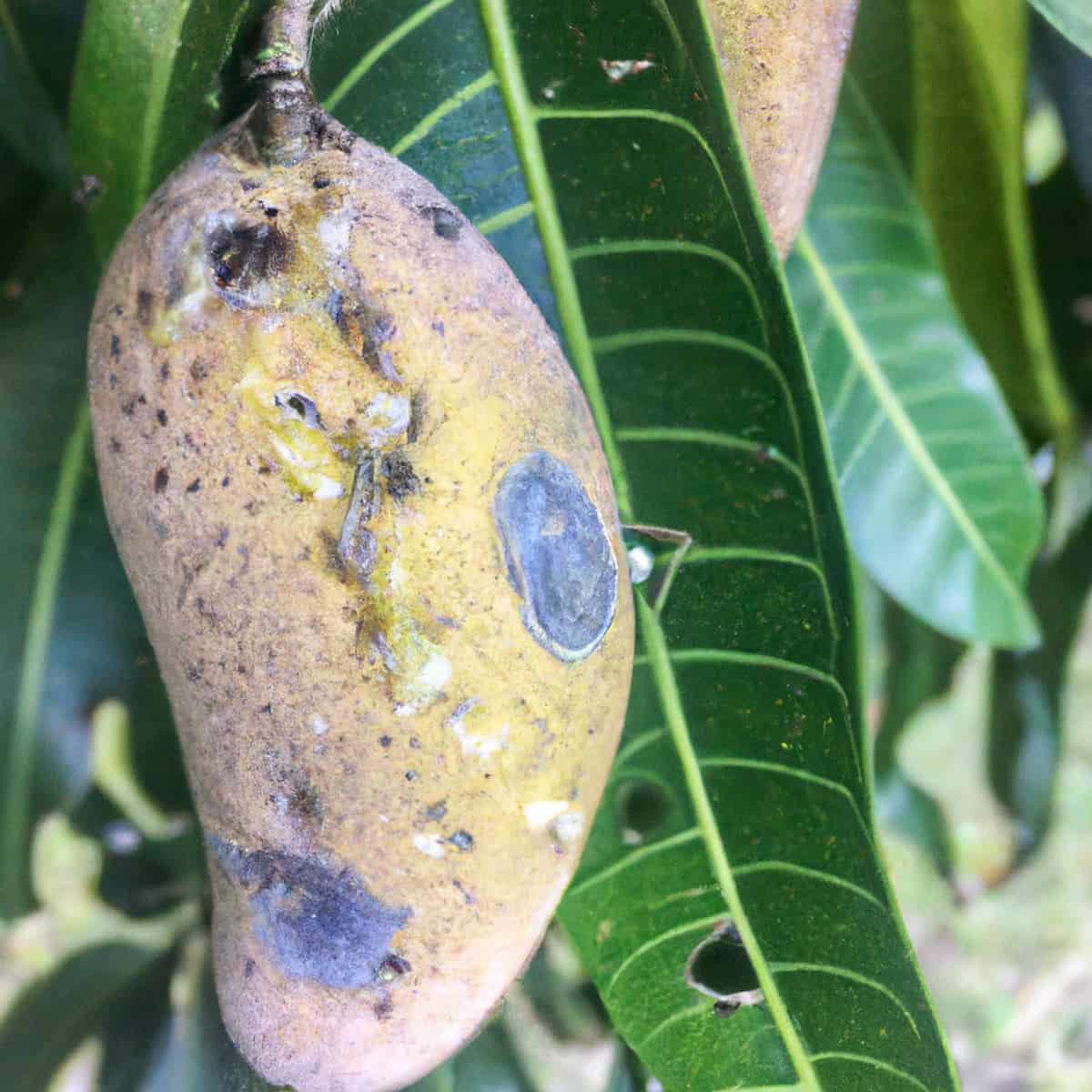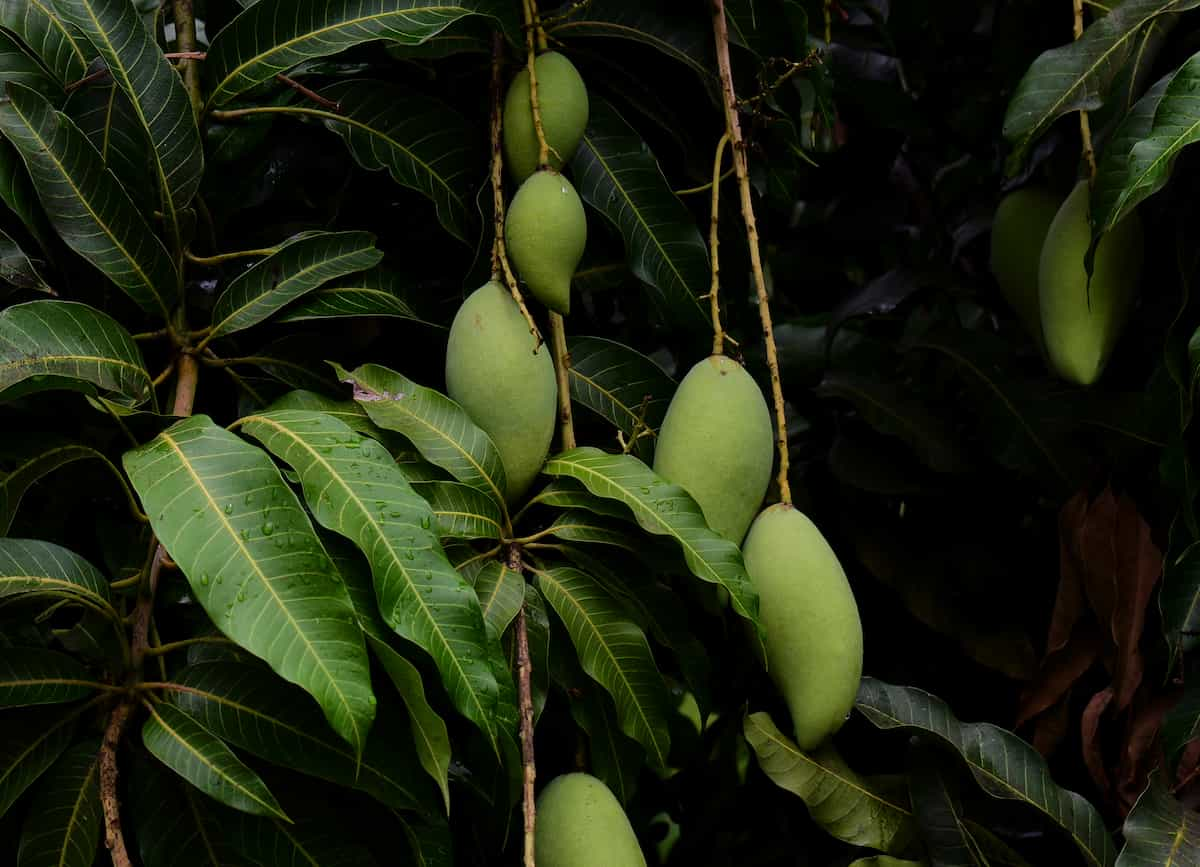The Mango Scab Disease caused by the fungus Elsinoë mangiferae is a huge threat to mango crops worldwide. The causal agent of this disease is responsible for scab-like lesions on leaves, fruits, and twigs. The disease can cause significant yield losses and reduce the quality of the fruit, resulting in economic losses for mango growers.

The Mango Scab Disease was first reported in India in the early 1900s and has since spread to many other mango-growing regions, including Southeast Asia, South America, Africa, and Australia. Effective management strategies involve a combination of cultural, chemical, and biological methods, and ongoing research is needed to develop sustainable solutions to control this disease.
To effectively manage this disease, it is important to understand its disease cycle, the mode of disease spread, and the best methods for controlling it. This article will provide an overview and discussion of the Mango Scab Disease in Mango crops, including its symptoms, identification techniques, and control.
Mango Scab Disease Management
The Causal Organism of Mango Scab Disease
- Elsinoë mangiferae is a facultative parasite that belongs to the Family Elsinoaceae of Order Myriangiales of the Phylum Ascomycota.
- The fungus is characterized by tiny, black, and round fruiting structures called ascomata or pseudothecia. These are the reproductive structures that contain asci, which are sac-like structures that contain ascospores.
- The ascospores of Elsinoë mangiferae are the primary means of dispersal and infection. The ascospores are hyaline and cylindrical, with a small, germ-like slit at one end.
- The fungus also produces spores called conidia. They are hyaline, single-celled, and cylindrical and are produced on small, olive-brown pycnidia, flask-shaped fruiting structures.
The Disease Cycle of Mango Scab Disease
The disease cycle of the Mango Scab Disease, Elsinoë mangiferae, in Mango Crops starts with the production of spores by the fungus. It produces two types of spores, ascospores, and conidia. The ascospores are produced in the pseudothecia fruiting structures embedded in infected tissue. The pseudothecia can remain dormant in the infected plant tissue or fallen debris until environmental conditions become favorable for spore release.
The ascospores are forcibly ejected when mature and can be carried by wind, rain, or insects to infect other mango trees. The conidia are produced in pycnidia found on the surface of infected plant tissue. The conidia can be easily spread by wind, rain, or human activity. The infection begins when the ascospores or conidia land on the surface of mango leaves, fruits, or twigs.
The spores can penetrate the host tissue through natural openings or wounds. Once inside the host tissue, the fungus grows and develops, causing lesions on the plant tissue’s surface. Once the fungus has infected the host tissue and caused symptoms, it enters the sporulation phase. During this phase, the fungus produces new spores, which can be released and spread to infect other mango trees, continuing the cycle.
Occurrence of Mango Scab Disease in Mango Crop
- Location of Mango Scab disease: This disease occurs in mango crops in India, Africa, Bangladesh, Sri Lanka, Thailand, the Philippines, the United States, Mexico, Brazil, and Australia.
- Host range: The most common crops affected by Elsinoë mangiferae are mango, cashew nut, and pistachio.
Favorable Conditions for Mango Scab Disease Spread in the Field
- The disease is prevalent in warm, humid, and rainy conditions and is more severe during the monsoon season, which coincides with the fruiting season of mango trees.
- The fungus thrives in warm temperatures between 25°C to 30°C and high humidity levels between 80% to 100%.
- The fungus can easily spread through water droplets, splashing onto leaves, fruits, and flowers.
- Overhead irrigation should be avoided, and mango orchards should be adequately drained to prevent the accumulation of standing water.
- The disease thrives in areas with low air circulation, such as dense orchards with closely spaced trees. Pruning trees, removing weeds and debris, and thinning-out branches can improve air circulation, reducing the chances of infection.
- Orchards should be kept clean and free from debris. Fallen leaves, fruit, and debris can harbor the fungus and facilitate its spread.
In case you missed it: Mango Root Rot and Damping-off Disease Management: Symptoms, Treatment, Chemical, Biological, and Organic Control

Damage Symptoms of Mango Scab Disease
- Mango Scab Disease primarily affects the fruit of the mango plant, causing blemishes, discoloration, and cracking. The fruit may become malformed as the disease progresses and drop prematurely, forming crack fissures and corky tissues.
- It can also infect the leaves, causing lesions, yellowing, and defoliation. As the disease progresses, it may become distorted and deformed.
- It can also infect the flowers, causing browning, drying, and falling of the flowers. Infected flowers may not develop into a fruit.
- The disease may only affect the leaves in mild cases, resulting in small, circular, and brownish lesions. However, the disease can severely affect the fruits, causing scabby lesions and cracks that can lead to fruit rot.
- The scab disease symptoms are often confused with those of anthracnose. The only difference is that there are raised structures in scab lesions, but in anthracnose, there are non-raised ones.
Percentage of Yield Loss Due to Mango Scab Disease in Mango Crop
- The disease can cause 50% yield losses in the United States. In Mexico, yield losses are 30%. In India, the yield losses are 50%. In Bangladesh, the losses are 40%. In Sri Lanka, the losses are 50%. In China, a 30% yield loss is seen.
- In Africa, yield losses are 50%. In the Philippines, it is 40%. In Thailand, it is 30%. In Brazil, it is 40%. In Australia, the losses are 30%. The Economic Threshold Level is determined at 5-10% of disease incidence.
Cultural Control Measures of Mango Scab Disease
- Proper pruning of mango trees can help improve air circulation, reduce humidity, and increase sunlight penetration. It is essential to sanitize pruning tools between cuts to prevent the spread of the disease.
- Proper irrigation and fertilization can promote tree growth and increase tree resistance to the disease.
- Weed management can help reduce humidity levels and create a more open and airier environment for the trees.
- Proper fruit harvesting practices, such as picking fruit when it is mature and avoiding mechanical damage during harvesting, can help reduce the spread of the disease.
- Maintaining clean orchards free from debris, fallen leaves, and diseased plant material can help reduce the inoculum load and the spread of the disease.
- Planting trees too close together can promote high humidity levels, reduce air circulation, and increase the disease’s severity. Proper spacing can help reduce the disease’s severity.
Biological Control Measures of Mango Scab Disease
- Trichoderma spp., Bacillus subtilis, and Pseudomonas spp. compete with the pathogen for nutrients and space and produce antibiotics that can inhibit its growth.
- Predatory mites, parasitic wasps, and beneficial fungi can feed on or parasitize the pathogen, reducing its population and spread.
Chemical Control Measures of Mango Scab Disease
- Spray Mancozeb, Zineb, Azoxystrobin, Trifloxystrobin, Tebuconazole, or Propiconazole to the foliage to control the fungus spread.
- These fungicides must be applied immediately after observing the disease to prevent further losses.
Organic Control Measures of Mango Scab Disease
- Spray Copper-based fungicides, such as copper oxychloride, copper hydroxide, or copper oxide, from the flower bud emergence stage to flowering at two to three-week intervals.
- Tea tree oil disrupts the pathogen’s cell membrane, causing it to die.
- Plant extracts, such as extracts from neem, ginger, garlic, and turmeric leaves, are used as a foliar spray or incorporated into the soil to suppress the disease.
Preventive Measures for Control of Mango Scab Disease
- Intercropping with legumes or cover crops can help promote the growth of beneficial microorganisms that can suppress the growth of the pathogen.
- Regularly monitoring the crops for signs of disease will help to find and manage the disease early before it spreads.
- Solarization should be done before planting trees to kill fungi and other soil-borne pathogens by covering the soil with a transparent plastic sheet to trap heat and increase soil temperature.
- Planting healthy and disease-free saplings is vital in preventing the spread of the disease.
- Always use sterilized and disinfected pruning equipment to prevent the spread of the disease to new trees.
In case you missed it: Mango Phoma Blight Disease Management: Symptoms, Treatment, Chemical, Biological, and Organic Control

Conclusion
The Mango Scab Disease caused by Elsinoë mangiferae is a severe problem in mango production that can cause significant economic losses. The integrated disease management approach is a promising strategy for managing the disease. This approach combines multiple control methods, including cultural, biological, and chemical, to reduce disease incidence and severity. Integrated disease management can contribute to the sustainable production of mango crops by reducing losses and improving overall health and productivity.
- Deworming Schedule for Dogs/Puppies: A Beginners Guide
- How to Prevent and Control Parasites in Goats
- Beneficial Insects in Pest Management
- Natural Solutions for Pest Control in Flower Gardens
- Types of Fungicides Used in Agriculture
- Common Issues in the Fruit Development Stage of Pomegranate Farming
- Fruit Development Issues in Papaya: Easy Solutions and Treatment
- Soil-Borne Diseases and How to Protect Your Plants
- Practices to Prevent Disease Spread in the Garden